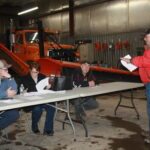
FORT FAIRFIELD, Maine — When new entrepreneurs come knocking, Fort Fairfield wants to make sure the town has enough space to welcome them.
After decades of being Aroostook County’s major downtown hub, Fort Fairfield’s Main Street began declining in the 1970s as the potato industry dwindled and major river floods knocked out businesses. Today only a handful of shops remain, and many buildings that once housed storefronts are empty, save for upstairs apartment units.
To revitalize Main Street, the new Fort Fairfield Revitalization Project has been exploring ways to entice future business owners. The group’s advocacy has led to the reversal of a longstanding trend that it believes prioritized housing over business development.
On Wednesday, town councilors unanimously approved banning apartment units from being developed or expanded onto empty ground floors of buildings along Main Street.
“There is a lot of need for housing, but this [new town ordinance] only targets our downtown Main Street,” said Pat Canavan, a town councilor and founder of the Revitalization Project.
Canavan said that at least three or four downtown buildings now have apartments upstairs but empty storefronts downstairs. If those apartments were expanded downstairs, it would not leave room for business growth, she said.
The new ordinance amends the town’s zoning code, which previously allowed new housing in any part of a downtown building. Apartments already approved for development, including a new senior housing complex slated to replace a former office park, are exempt.
In its heyday of the 1950s and 1960s, Fort Fairfield boasted local hardware, clothing and jewelry stores, pharmacies, restaurants, hair salons and other small businesses. The town’s status as the major potato farming hub kept entrepreneurs in town until more mechanized equipment and competition from western states drew away farm families.
Flooding from the Aroostook River in the 1970s led town officials to sign up for the federal urban renewal program to clean up blighted buildings. But over time, more of those empty spaces became parking lots.
Fewer businesses came to town once Loring Air Force Base closed in 1994, and a massive flood that same year ruined more buildings.
Eventually, apartment units came to dominate Main Street. Several buildings with those units still have vacant ground floors, prompting town leaders to preserve them.
“The idea is for Main Street to not turn into just apartment houses,” said Interim Town Manager Dan Foster. “It would be nice to have more businesses there.”
So far, those involved with town revitalization have seen their new monthly Main Street vendor and activity series, Fridays in Fort, generate more interest among potential business owners.
The Revitalization Project’s committee is exploring a potential co-op that would be open to multiple artisans, crafters and other business owners who might be able to afford to lease, but not own, their own commercial space.
Preserving ground-level storefronts is the first step toward possibly making new business ventures a reality, Canavan said.
“We have a lot of ideas to revitalize and energize Main Street, but we’re limited if there isn’t space available for businesses,” Canavan said.







